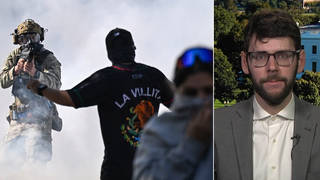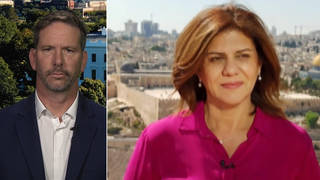
Guests
- Tamara Lanierthe great-great-great-granddaughter of Renty, an enslaved man whose image was captured in mid-19th century photograph owned by Harvard University. She is suing Harvard for the return of the images.
- Ben Crumpcivil rights attorney.
Who has the right to own photos of slaves? We speak with Tamara Lanier, the great-great-great-granddaughter of Papa Renty, the enslaved man whose image was captured in a 19th century photograph currently owned by Harvard University. She is suing the school, accusing it of unfairly profiting from the images. We also speak with her attorney, Benjamin Crump.
Transcript
JUAN GONZÁLEZ: We begin in Massachusetts, where the descendant of two enslaved people who were captured in mid-19th century photographs has sued Harvard University, accusing the university of unfairly profiting from their images. Tamara Lanier of Connecticut argues, in a lawsuit filed this month, that she and other descendants of Renty and Delia, two people held in bondage 169 years ago, should hold the rights to their photographs, not Harvard. Renty and Delia were forced to pose for the photographs in 1850 by a well-known Harvard professor, Louis Agassiz, and he commissioned the images to support his theory of polygenism, which purports that human races have different origins and that Africans and African Americans were inferior to whites. The theory was used to justify the ongoing enslavement of black people prior to the Civil War, as well as segregation.
AMY GOODMAN: The images of Renty and Delia were used in a recent Harvard conference titled “Universities and Slavery: Bound by History.” This comes after administrators at Harvard and other elite universities have admitted they were founded largely through the labor of enslaved African people and profits generated by the slave trade.
Well, for more, we’re joined by two guests. Tamara Lanier is the plaintiff in the lawsuit against Harvard University, the great-great-great-granddaughter of Renty, the enslaved man whose image was captured in the mid-19th century daguerreotype owned by Harvard. Also with us, famed civil rights lawyer Benjamin Crump, representing Tamara Lanier in the lawsuit against Harvard University over the images of her ancestors.
We welcome you both to Democracy Now! Tamara, let’s begin with you. Explain how you discovered that Harvard had these photographs of your relatives, of your ancestors.
TAMARA LANIER: It’s quite an amazing story, that started with a request by my mother that I document our lineage, our genealogy. And at her passing, I set out to do exactly that. And that was in 2010, where the internet wasn’t as—the information wasn’t as readily available as today. And I happened to be out walking for lunch one afternoon, and I stopped into a small ice cream shop. And I was speaking with the owner about my dilemma, and he offered to help. And it was actually him, Richard Morrison, of Norwich, who found the images on the internet.
AMY GOODMAN: Found the images. And how did you know that Renty was your great-great-great-grandfather?
TAMARA LANIER: As a child, my mom often talked about her enslaved ancestors, particularly the man in the image, who she fondly referred to as Papa Renty. And she also talked about the fact, you know, of our lineage, how our family was broken apart by slavery. She remembered some of the family names. And so, when I met with Rich that afternoon, I gave him the names and the information that my mom had shared with me. And I didn’t return to the ice cream shop for a while thereafter.
But when I did return, he said he had found amazing information on the internet, and particularly a picture of my grandfather. And the images—the information that Rich sent me included a narrative about who Louis Agassiz was. But he sent me an email with a number of links. And I remember reading the information about Louis Agassiz and being overwhelmed and shocked by it. And then, when I opened the link to the picture of Renty, it was a moment for me, because I knew immediately that this was the man that I had heard so much about throughout my childhood.
JUAN GONZÁLEZ: And, Benjamin Crump, could you talk about what you know of how Harvard acquired or utilized these photographs, and why your lawsuit argues that they never legally owned the images that they are profiting from?
BENJAMIN CRUMP: Certainly. It was the director Steve McQueen who told the story of Solomon Northup in his Oscar-winning movie 12 Years a Slave. Well, Renty is 169 years a slave. And the basic questions that our lawsuit asks is, one, “How long will Harvard continue to condone slavery?” and, two, “When will Harvard University finally free Renty?”
Harvard University’s professor Louis Agassiz was a racist. While Abraham Lincoln was talking about Emancipation Proclamation, he was going around the country professing that he could prove scientifically that black people were inferior to white people. He was an equal opportunity bigot, because he also fought to keep Jews and people from Ireland out of Harvard University. But in particular, he was focused on black people, proving that they were inferior. And so he wrote all these horrible things about black people to justify the continued enslavement of black people.
And he sought to obtain ocular proof. And that’s why he went down to South Carolina, because he was looking for a “pure African,” because after the ban on transporting slaves and importing slaves into America in 1807, many of the slave masters had sexually assaulted and raped so many black women that there were very few “pure Africans,” as Louis Agassiz had noted. So, he went to Charleston, South Carolina, and started looking there. But he found, in Columbia, South Carolina, at Benjamin Franklin Taylor’s plantation, Renty and his daughter Delia. And he—they were referred to as “the black African.” And I remember Tamara asking her mother, “But why did they call them 'the black African'? We’re all from Africa.” She did not know at that time about Louis Agassiz and that he was referred to as “the black African” because everybody knew that he was a “pure African.” And this is what Louis Agassiz had been looking for to support his racist beliefs.
JUAN GONZÁLEZ: And in terms of how Harvard—Harvard only discovered these photographs—right?—that they were stored in a file cabinet in one of its museums—back about 40 years ago. Could you talk about how they’ve used them since?
BENJAMIN CRUMP: Yes, sir. Harvard has used the pictures. They’ve licensed them. These daguerreotypes are very, very valuable. They are the earliest known photographs of American slaves and some of the earliest known photographs in America using this daguerreotype. And so, Harvard licensed them to be used in films. They were seen apparently in the movie Roots. And they’ve been used in several books. They are located in the Peabody Museum, that charges reproduction fees and such.
But really, it is priceless to Tamara Lanier and her family, because they’re the linear descendants. And when Abraham Lincoln and the United States government freed black people in America, we didn’t have any land. We didn’t have 40 acres and a mule. We at least believe when we were freed, we had the right and ownership to our person. And incumbent in that was our image. But Harvard is telling Ms. Lanier and her family, “No, no, Renty still belongs to us. He’s still our property.”
And so this lawsuit just isn’t about Tamara and the linear descendants of Renty; it really is about the linear descendants of all African slaves in America, because slavery was meant to make sure that we’ve had no familiar pedigree, that we could not trace our lineage. That’s why they would break up the male and the female after they procreated, and they would take the children from their parents, because they did not want us to have a concept of family. They wanted us to think of ourselves only as property. And that’s why it’s so miraculous what Ms. Lanier has done and being able to prove the linear descendancy of her family, because many of us black people in America, we cannot do that, because the primary foundation of slavery was to make sure we couldn’t do that, when they sold us off and changed our last names to whoever the plantation owner was.
AMY GOODMAN: In 2016, Harvard University installed a plaque to commemorate four enslaved people who lived and worked at Wadsworth House, the one-time home of Harvard presidents. In an article for The Harvard Crimson, then-Harvard President Drew Faust wrote, quote, “Slavery is an aspect of Harvard’s past that has rarely been acknowledged or invoked. … But Harvard was directly complicit in America’s system of racial bondage from the College’s earliest days,” unquote. This is Harvard University former President Faust speaking at the unveiling of the plaque.
DREW FAUST: Today we will unveil a plaque that will document the presence of four enslaved individuals in the households of two Harvard presidents who lived in Wadsworth House. Titus, Venus, Bilhah and Juba lived there, too. The plaque is intended to remember them and honor them and to remind us that slavery was not an abstraction, but a cruelty inflicted on particular humans. The past never dies or disappears. It continues to shape us in ways we should not try to erase or ignore. We must never forget.
AMY GOODMAN: So, that’s past Harvard University President Drew Faust speaking at the unveiling of this plaque. Tamara Lanier, as you hear her speak, your thoughts?
TAMARA LANIER: Well, interestingly enough, I received notice of that meeting from someone on social media, and I wrote to her and asked if I could attend that event, and I was denied, or I was told no. What resonates with me in that statement is when she talks about the past will never die and it will continue to shape us in ways that we shouldn’t ignore or forget. That’s exactly what she did with Renty and his legacy. At that time, she knew about Renty. She knew about me. She knew the stories that I’ve shared with everyone else. And I specifically asked her, “Why is it that Harvard, the keeper of these images, is seemingly not interested, when the entire world is amazed?” And that would have been a great opportunity to reference their legacy with slavery in Renty. But every time they had the opportunity to do the right thing by Renty, they chose not to.
JUAN GONZÁLEZ: I wanted to ask you about that, because this lawsuit comes after numerous attempts by you to contact different parts of Harvard University to try to get some response.
TAMARA LANIER: Yes.
JUAN GONZÁLEZ: Could you talk about that, who you reached out to, and what led you finally to say, “I have to file a lawsuit”?
TAMARA LANIER: Virtually everyone. I sent emails. I think, ultimately, Dr. Faust was the last person in Harvard I reached out to. At that time, I think there was the W.E.B. Du Bois Institute. I spoke with professor Charles—at that time he was professor, not doctor—he may have been Dr. Charles Ogletree. I sent emails to Henry Gates.
AMY GOODMAN: And what did Charles Ogletree say?
TAMARA LANIER: He was very supportive. He referred me to the Cambridge branch of the NAACP. I did travel to Cambridge and attended one of their meetings, where this was discussed, but not really much traction from that resource. I wrote to history departments, history professors. Again, as I explained in my email to Dr. Faust, I have sent emails almost to the point of ad nauseam, and no response.
JUAN GONZÁLEZ: I’m curious what the response of Henry Louis Gates was, since he has spent so much time dealing with heritage and lineage and ancestry.
TAMARA LANIER: He didn’t respond.
JUAN GONZÁLEZ: He didn’t respond at all.
TAMARA LANIER: Not at all.
AMY GOODMAN: So, Benjamin Crump, you have called your lawsuit the most important lawsuit since Brown v. Board of Education. Talk about why.
BENJAMIN CRUMP: Certainly, especially as it relates to civil rights. Attorney Mike Koskoff and I have put forth this claim based on well-established precedents of property law. We’ve argued replevin, conversion, unjust enrichment, and, Amy, something very novel to be pled in contemporary pleadings, we argued that the 13th Amendment of the United States of America, which gave blacks not only the right to be free, but also the right to own property and to enter into contracts. And so, when Renty was freed in 1865, incumbent in that was his right to own his own image.
This is critical when you think about what Harvard is saying, that “We own the rights, not your linear descendants.” Black people didn’t get any inheritance from any of our family members, because we were slaves. We couldn’t own anything. And so, this lawsuit will speak to many issues that America has never sought to grapple with. They have just assumed that descendants of Africans should not be given anything for our contributions to this country, our over 400 years of free labor building this economy, bearing the cross on our back to make sure that America was able to thrive in the world. And so this lawsuit will speak to that. And if we’re successful, it will be the first time that descendants of African slaves are ever given any kind of compensation, any way that the harm has been repaired from slavery.
Until Harvard condones—condemns what Agassiz did—because they have never done that—there will be a stain on their legacy as one of the world’s leading educational institutions, their alumni diplomas will have a taint on it, and there will always be that asterisk there, that they are continuing to condone slavery, because your actions speak louder than your words. And so far, your actions to Tamara Lanier has been outrageous, when you think about their dismissive nature to her. Harvard, you’re better than this.
JUAN GONZÁLEZ: And in terms of this long history of the country failing to live up to what was done during slavery, this calls to mind the Henrietta Lacks story with Johns Hopkins—
BENJAMIN CRUMP: Exactly.
JUAN GONZÁLEZ: —and them benefiting from her cells. It also comes at a time when there’s at least a few, for the first time, presidential candidates actually raising the issue of reparations for descendants of slaves here in the United States. I’m wondering if you could put it in that broader context of the reparations issue?
BENJAMIN CRUMP: Certainly. Even though this is well founded in property law, we would be naive to assume people won’t see this as a reparations lawsuit. However, we understand that courts don’t want to create laws; they leave that for the legislature. But make no mistake about it: It is landmark in its scope, because it will be the first time that descendants of African slaves in America have been compensated in any way, fashion or form from an American institution. And remember, Harvard is readily believed to be the leading American educational institution, with an endowment of $30 billion.
These photographs have an invaluable meaning to Ms. Lanier, but also to many people who are descendants of slaves. And why should it be locked away at Harvard University? Why shouldn’t these daguerreotypes, these photographs, be used to tour the country and be able to talk about these issues of white supremacy that we thought we had overcome? But we know from Charlottesville, Virginia, in recent years, that it has been in vogue again to express that white supremacy may not be as bad as we, as society, has proved it to be, by many people. And to have the president of the United States say that there were good people on both sides is even more alarming. It makes Renty’s fight even more relevant. And the young people, students all around the country have been signing petitions and starting to have marches to free Renty. It really heartens me, and it reminds me of what I did in college with Nelson Mandela, when we were talking about the need to have an abolishment of apartheid in South Africa. So, we take great solace regardless of what happens in the court of law, because they don’t always get it right, but we take great solace in knowing that we are on the right side of history, and Harvard is not on the right side of history.
AMY GOODMAN: Finally, Tamara Lanier, we give you the last word. What do you want to see happen to these photographs?
TAMARA LANIER: Well, I certainly want to consider all of the options. The one thing that I have talked about with my attorneys and with my family is, it’s important for me that people know who Renty is and also who—or, who Renty was and who Agassiz was. And I hope that there is a greater education or a reteaching of history, so that we can dispute the legacy that Agassiz has kind of stained my family with.
AMY GOODMAN: His name is all over Harvard.
TAMARA LANIER: His name is all over Harvard. His name is all over this country and parts of South Carolina and the world. And I think that that’s also an interesting point to share. I’m not only getting support from people all over this country; I’m getting international support. And I heard from a young lady in Helsinki, Finland, the other day, where she said, “The world is watching.” And it’s because she believes that the United States has never atoned for the sins of slavery, and she believes that this case will be that first opportunity.
AMY GOODMAN: Well, I want to thank you, Tamara Lanier, for joining us today. She is suing Harvard for the return of the images of her ancestors, her great-great-great-grandfather, Papa Renty, and his daughter Delia. And thank you very much in Dallas, Ben Crump, famed civil rights attorney, who is representing Tamara. We will follow this case.
This is Democracy Now! When we come back, Solitary: Unbroken by Four Decades in Solitary Confinement, the story of Albert Woodfox, held in solitary longer than any person in the United States, out after 43 years. Stay with us.












Media Options